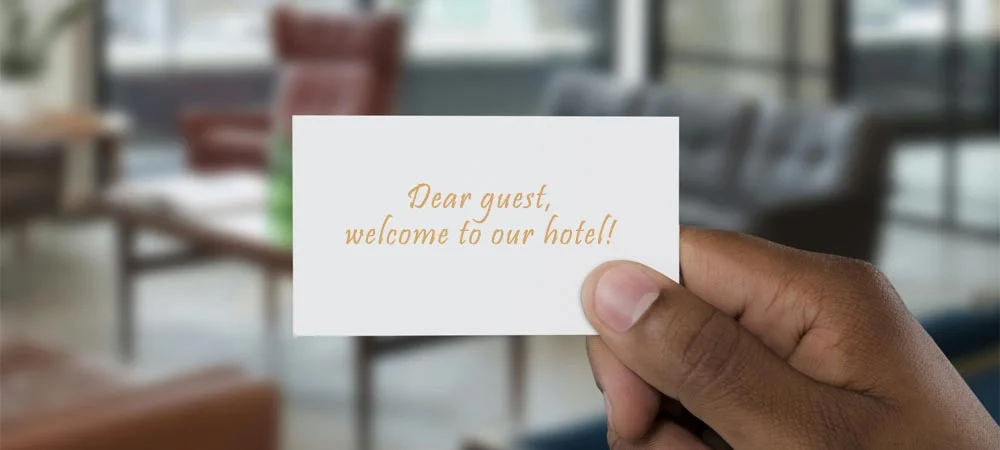A hotel welcome card is a personalized note, left on a card for guests to read upon arrival. It is similar to a welcome letter, but will typically be shorter, including only the most essential information. Learning to write a hotel welcome card is important because these messages set the tone and provide details that enhance a guest’s stay. Leaving a card is a small touch that can make a big difference to how guests perceive a hotel. In this article, you will learn how to write an effective hotel welcome card, complete with five examples.
Table of Contents:
- What is a Welcome Card for Hotel Guests?
- Why is a Hotel Welcome Card Important?
- 7 Tips on How to Write a Hotel Welcome Card
- 5 Free Hotel Welcome Card Examples
- How to Deliver Your Message: Digital and Physical Hotel Welcome Cards
- Creating the Ideal Hotel Welcome Message
- How to Write an Excellent Welcome Letter
What is a Welcome Card for Hotel Guests?
A hotel welcome card is a short note, written on a card, which is used to greet guests. Typically, this note will thank guests for choosing the hotel and then provide some important information about services.
Essentially, a welcome card for a hotel guest will function like a smaller version of a welcome letter. It will cover the most critical information, while helping to make the guest feel valued. The best hotel welcome cards are personalized, using customer data and booking details, so the message is relevant to the individual guest.
In many cases, welcome letters are produced with the help of CRM software, meaning personal details can be quickly added to each card. The card will usually be left in the hotel room prior to the guest’s arrival, so they can read it once they have checked in. However, some hotels slip the card under the door after the guest has arrived.
Why is a Hotel Welcome Card Important?
Welcome cards help to shape a guest’s first impressions of your hotel. They also provide you with a great opportunity to highlight services and amenities.
A welcome card for hotel guests can help to build rapport and can make your hotel staff seem more friendly and approachable. When the card is personalized, it can also help guests to feel valued as individuals. A card also allows you to highlight some of your brand values and enhance your brand image.
When a hotel welcome card is designed carefully, it can encourage guests to visit your hotel restaurant, or make use of some of the services you offer. As a result, you may then earn additional revenue. Your message to hotel guests can also encourage feedback and online reviews, which helps you to optimize services and your reputation.
Video: The Best Way to Welcome Guests to Your Hotel
7 Tips on How to Write a Hotel Welcome Card
In the sections that follow, you will find useful tips to assist with writing a hotel welcome card.
1. Personalize Your Hotel Welcome Card
Personalization is the process of making services or offerings feel like they have been tailored for individuals. A hotel welcome card can be tailored to make guests feel respected and appreciated by hotel management.
A personalized welcome card is important because it means the message is more likely to resonate with each guest. It also demonstrates an attention to detail that will impress visitors. Address the guest by name and include relevant details for the type of booking or type of guest they are. This makes the card more meaningful and less like a generic welcome message.
2. Thank Your Guests for Choosing You
A simple ‘thank you‘ message is a great way to begin a hotel welcome card. It shows guests that you are grateful they selected your hotel instead of a competitor.
Expressing gratitude of this kind is crucial because it gets your relationship off to a positive start. It also helps to convey that you do not take your customers for granted. A ‘thank you‘ is a small gesture that can make a great impression. It may even be a good idea to bookend the content with an initial ‘thank you’ and then a ‘thanks again’ message at the end.
3. Highlight Key Facilities and Amenities
Your hotel welcome card is a great place to highlight hotel facilities and amenities. Examples of facilities include spas, gyms, restaurants and pools, while amenities are the little extras, like Wi-Fi and bath robes.
Highlighting these features is important because it draws attention to them. It can help you to generate additional revenue, but most crucially, using these facilities and amenities can enhance the guest experience. The hotel industry is extremely diverse, and the precise elements of the hotel you reference in a welcome card for hotel guests will vary depending on the image you are trying to project and the type of customer you are writing the card for.
Video: 11 SUPER EASY HOSTING TIPS FROM 5 STAR HOTELS — IMMEDIATELY MAKE YOUR GUESTS FEEL WELCOMED!
4. Include Important Contact Information
The most essential contact information can also be added to your hotel welcome cards. This may include a phone number for the front desk, an email address for providing customer feedback and a phone number for room service.
Providing this information on your welcome card is a great idea because it means guests can easily refer back to it. It may also give guests the confidence to ask questions or make requests that will improve their stay.
To make communication even easier, you could also add a QR code for a hotel app or provide a smart speaker or similar hotel technology. Give guests options and refer to them on your hotel welcome card.
5. Openly Promote Employee Attentiveness
One of the best ways to impress hotel guests is with attentive staff. You can boost your chances of impressing guests by openly promoting how attentive your employees are going to be.
It is essential that guests feel confident enough to actually ask for help. Use your hotel welcome card to make clear that your team is always available and willing to provide assistance and support.
You can enhance this approach by highlighting your team’s willingness to go the extra mile in hotel marketing content. Of course, you also need to back up these claims and ensure staff are friendly, with good attention to detail.
6. Consider a Call to Action in Your Message
A call to action is a written prompt, which encourages the reader to perform a specific action. This technique can be effective for upselling, cross-selling and generating additional revenue in other ways.
Including a call to action in your hotel welcome card can directly encourage guests to try out your restaurant, bar, spa services, gym, or sports facilities. It can also help to convince guests to explore the hotel. Ultimately, your chosen call to action should be based on the type of guest you are dealing with.
7. Try to Keep Your Hotel Welcome Card Brief
A welcome card for hotel guests is not supposed to be a comprehensive explanation of facilities, features, and offerings. Try to keep the message as concise as possible, while covering the main topics.
Brevity is vital, because your card is supposed to be a quick, easy to consume message. If you make the message too long or complex, some guests will avoid reading it. Thank the guest, provide them with important information, make clear you are willing to help, and then end the message.
5 Free Hotel Welcome Card Examples
Here, you can access five free hotel welcome card examples, which you can use as the basis for your own cards.
Example 1: The Classic Hotel Welcome Card
Dear [Name of Guest]
Welcome to [Hotel Name]! We’re thrilled you have chosen our hotel and we really hope you enjoy your time here. Please don’t hesitate to speak to a member of staff if you need any assistance, or if you have any questions or concerns.
Sincerely,
The whole team at [Hotel Name].
Example 2: A Hotel Welcome Card With Local Expertise
Dear [Name of Guest],
Welcome to [Hotel Name]: the ideal base for exploring [Destination Name].
To make things easier, we’ve prepared a welcome bag, which includes a list of nearby visitor attractions, places of interest, bars and restaurants. Our friendly and knowledgeable concierge staff can also assist you with further recommendations and itinerary planning.
If you have any questions or require assistance of any kind, don’t hesitate to reach out to us.
We hope you enjoy your stay.
Sincerely,
The staff at [Hotel Name].
Example 3: A Family-Oriented Hotel Welcome Card
Thank you for visiting [Hotel Name]!
We’re honored you and your family have chosen to stay with us. We’re confident your children will love our family pool area, and we urge you to try out the kids’ menu at our hotel restaurant.
If you require any assistance to make your stay more pleasant, don’t hesitate to ask.
We hope you enjoy your time here!
Sincerely,
The [Hotel Name] Family
Example 4: A Hotel Welcome Card for Business Travelers
Dear [Name of Guest],
Thank you for choosing [Hotel Name]. We hope your stay is a pleasant one.
We understand you are visiting for business purposes. To make life easier, we offer free and fast Wi-Fi access. The Wi-Fi details are as follows: [Wi-Fi Name and Password].
Our designated business center is located on the ground floor and provides 24/7 access to printing and copying facilities. If you have any other needs, concerns or questions, don’t hesitate to get in touch.
Sincerely,
[Your Name]
Front Office Manager
[Hotel Name]
Example 5: The Handwritten Hotel Welcome Card
Hello!
Welcome to [Hotel Name]! I am thrilled you’ve chosen to join us, and I hope you have a pleasant stay. If there’s anything I can do personally to improve your time here, please let me know.
Sincerely,
[Your Name]
Hotel Owner / Hotel Manager
How to Deliver Your Message: Digital and Physical Hotel Welcome Cards
There are two main ways to deliver your hotel welcome card: physically or digitally. Traditionally, physical cards have been left in guest rooms, but some hotels now opt for a digital approach.
This decision is important because you need to think about what your approach says about your hotel. You might also decide to use a different approach based on guest type or individual preferences.
When you opt to leave a physical welcome card for a hotel guest, it is best to leave the card somewhere visible within the hotel room, ready for the guest’s arrival. Alternatively, the digital approach has emerged as one of the fastest-growing hotel trends and involves sending messages via email, SMS, or your own hotel app.
Creating the Ideal Hotel Welcome Message
A welcome message is a possible alternative to a hotel welcome card and may be chosen when a manager decides the greeting should be sent digitally. Some hotel welcome messages have a similar function to a welcome card, but others are actually sent before arrival, serving as a sort of hotel advertisement for confirmed guests, highlighting key services.
In the “Hotel Welcome Message for Guests + 5 Free Examples” article, you can learn more about hotel welcome messages and the role they serve. You will also have access to five free example messages.
How to Write an Excellent Welcome Letter
A hotel welcome card can be a great way to welcome guests to your property, but some hotels opt to take a longer-form approach by writing a welcome letter instead. This allows you to go into slightly more detail and can sometimes feel more formal and professional than opting for a card.
In the article “Hotel Welcome Letter for Guests + 8 Free Templates“, you will find a complete breakdown of how to write a great welcome letter, along with eight templates you can use as a starting point.
A hotel welcome card is a useful way of greeting guests and providing valuable information. It is recommended you take the time to personalize these cards as much as possible, so they are targeted and relevant to individual customers.
More Tips to Grow Your Business
Revfine.com is the leading knowledge platform for the hospitality and travel industry. Professionals use our insights, strategies, and actionable tips to get inspired, optimize revenue, innovate processes, and improve customer experience.Explore expert advice on management, marketing, revenue management, operations, software, and technology in our dedicated Hotel, Hospitality, and Travel & Tourism categories.
This article is written by:
Hi, I am Martijn Barten, founder of Revfine.com. With 20 years of experience in the hospitality industry, I specialize in optimizing revenue by combining revenue management with marketing strategies. I have successfully developed, implemented, and managed revenue management and marketing strategies for individual properties and multi-property portfolios.










Leave A Comment